JANUARY 24, 2019
Edmund Boulevard--which extends for 14 blocks along the Mississippi River-- is one of the loveliest streets in Minneapolis. Canopied by trees and lined with prosperous homes, it runs parallel to West River Parkway, one leg of the city’s celebrated Grand Rounds.
The natural beauty of the street obscures some ugly history. Edmund Boulevard is blanketed by racial covenants, which reserved this area for the exclusive use of white people.
The street is also named for the man who brought racial covenants to Minneapolis. The tony residential boulevard honors its eponymous developer, Edmund Walton, a British-born son of a silk merchant who arrived in Minneapolis in the 1880s and made a fortune in residential real estate before his death in April, 1919.
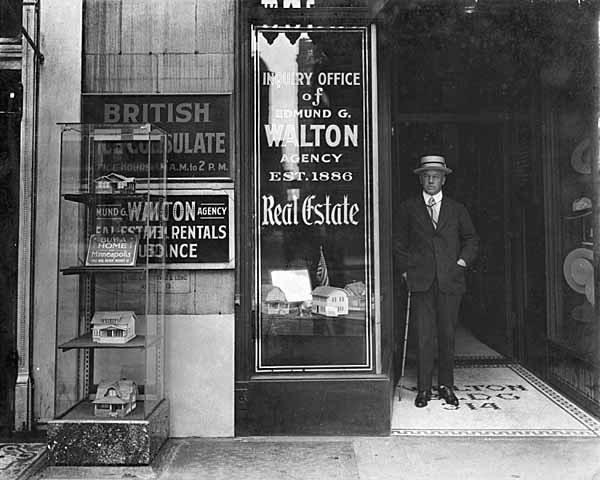
Edmund G. Walton outside his real estate office at 314 Nicollet Avenue, around 1916. Image from the Minnesota Historical Society.
Walton developed at least 40 housing additions in the city, many of which still bear Edmund’s name. It’s easy to see his legacy in deeds to homes in Walton’s Lyndhurst, Walton Hills Second Addition or Walton's Camden Place Additions.
Less obvious is Walton’s role in creating the racial restrictions that blanketed Minneapolis. Walton was almost certainly the author of this text from 1910, which became the first racial covenant entered into a property deed in Minneapolis:
The premises hereby conveyed shall not at any time be conveyed, mortgaged or leased to any person or persons of Chinese, Japanese, Moorish, Turkish, Negro, Mongolian or African blood or descent. Said restrictions and covenants shall run with the land and any breach of any or either thereof shall work a forfeiture of title, which may be enforced by re-entry.
The racial restriction was part of a transaction between Walton’s business partner Henry Scott and Nels Anderson, who built a modest home at 3252 36th Avenue South. This sale was a test of a new marketing tool. Over the next two decades, covenants would become a standard part of real estate transactions all over the country.
Walton likely composed this covenant, which contained a laundry list of people he deemed to be “undesirable” and damaging to property values. Thanks to the success of the Seven Oaks Corporation he created with Scott, this language was reproduced in thousands of Minneapolis deeds. Walton offered these kinds of discriminatory deeds as a bulwark against insecurity for potential buyers; racial homogeneity would guard their investment in a home.
Walton was a pathbreaker. But he was hardly alone. He was an organizing member of the Minneapolis Real Estate Board and was active in the National Association of Realtors. Working in concert with his colleagues in the real estate world, he embedded white supremacy into property development in Minneapolis. Walton was on the cutting edge of an industry that was changing the way that American cities were organized at the beginning of the twentieth century.
A prominent figure in Minneapolis, Walton was a novelty in a city controlled by New England puritans and inhabited by thousands of Scandinavian stoics. He was able to capitalize on his unique position, explaining to his mother in 1887 that he was “working to get into society this winter” where he could “use my conversation talent to bring me connections and business.” His British accent and mannerisms allowed him to tap into American Anglophilia, cultivating assumptions of Anglo-Saxon cultural superiority for commercial gain in Minneapolis.
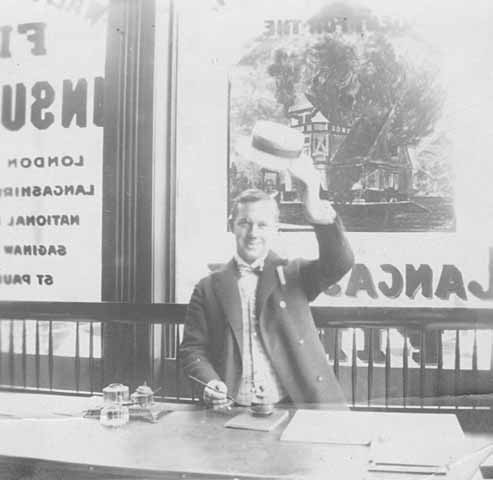
Edmund G. Walton at his real estate office in 1910, the same year that he introduced racial covenants to Minneapolis. Image from the Minnesota Historical Society.
And he met great success. As a real estate developer, Walton combined audacious speculation with flamboyant salesmanship, developing a pitch that spoke to the fears and fantasies of early twentieth century homebuyers. He played on Anglophilia to give buyers a sense of exclusivity. He emphasized the security brought by property ownership. And he spoke in flowery language of the joy of homeownership. “Tis always the same, one man gets all the good things and I’m always the man,” he boasted in 1909 advertisement for lots along Edmund Boulevard. We “are offering a few sites today as an Extraordinary Possibility to those who will adore the banks of this most romantic, wonderful river with pretty homes and dainty gardens. To those who have never stood upon these lots, I say you have wonders to behold--long stretches of woodland, water and wonderful vistas that are only equalled in Yellowstone Park.”
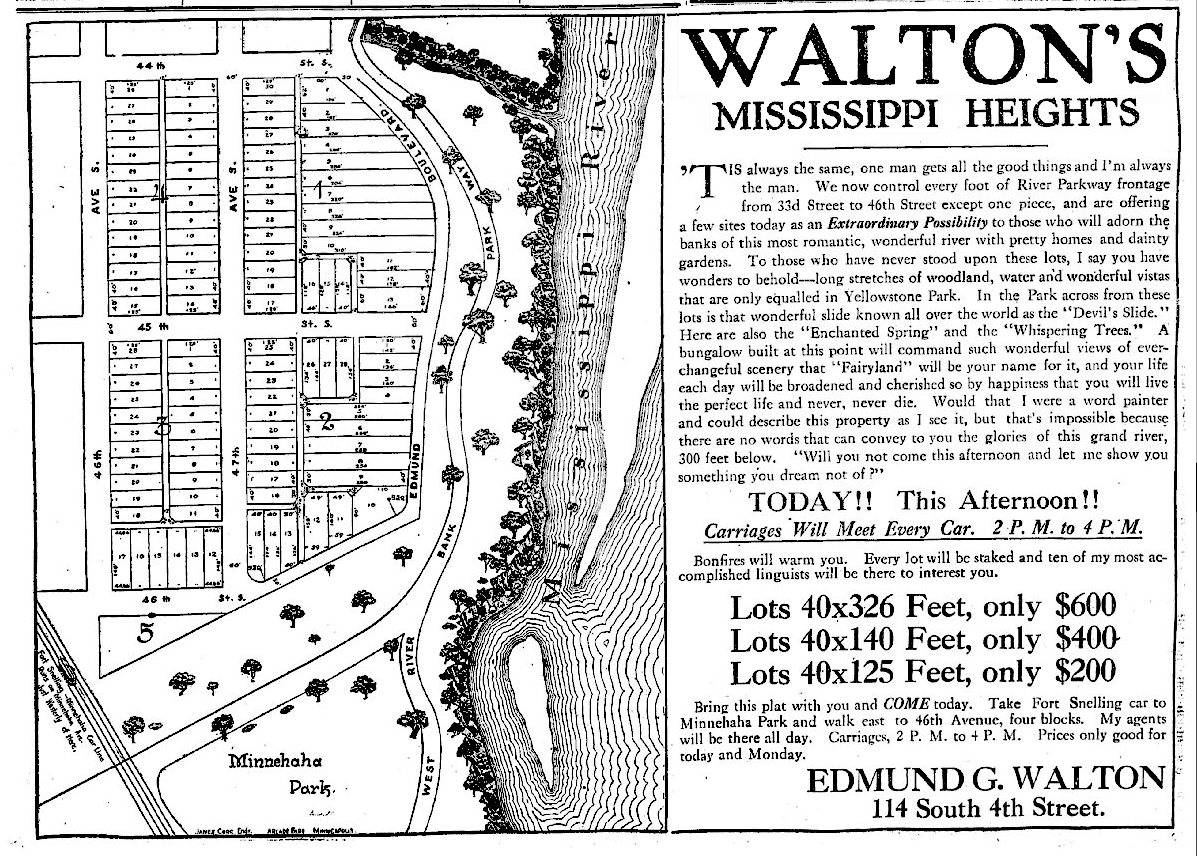
Edmund G. Walton advertisement, Minneapolis Tribune, January 17, 1909.
To entice prospective homeowners to gamble their life savings on this vision of happiness and security, Walton also drew on the cultural fantasies of the settler colonialism that was ascendant in Minneapolis at the time. Since 1889, when Minneapolis christened Minnehaha Park after the protagonist in Henry Longfellow’s poem Hiawatha, the city had embraced fictional “noble Indians” as symbols of a new regional identity. City leaders imprinted the developing urban landscape with names from Longfellow’s poem--Hiawatha, Minnehaha, Nokomis--to claim the poem’s “noble” Indians as icons of civic distinctiveness. Most white Minnesotans believed that nearly all “real” Indians had “disappeared” in the wake of civilization.
Walton embellished this literary fiction, crafting stories to sell property that erased the original inhabitants of the land that he had parceled out for the exclusive use of whites. He claimed that the lots along the Mississippi River “were unique” with their “commanding” views over the river and their proximity to what he called a “Spinney.” This site, he asserted in marketing materials: “was used as a meeting place, possibly a war council rendezvous, or a place of worship by some gone and forgotten tribe of Indians.”
Racial fears and fantasies were central to Walton’s marketing strategy, which was remarkably successful. Walton was able to shape the development of large chunks of Minneapolis during the years when the city was growing most rapidly.
After less than 10 years in Minneapolis, Walton had amassed enough wealth to construct Grey Court on Mount Curve Avenue, where his neighbors were the other plutocrats of Minneapolis. Grey Court was an ostentatious residence that matched Walton’s flamboyant salesmanship style.
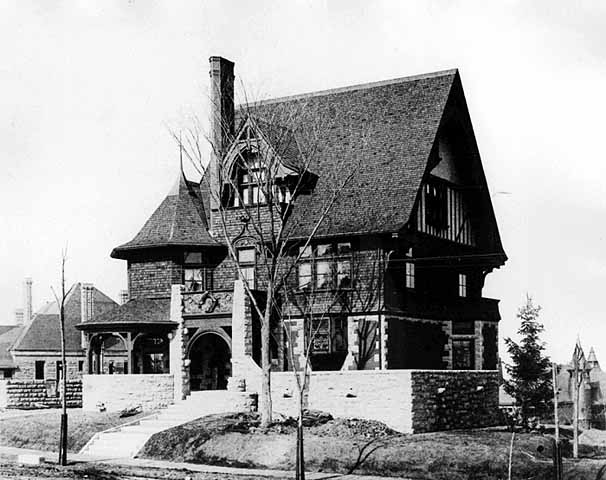
Exterior of Grey Court, home of Edmund G. Walton, 802 Mount Curve Avenue, c. 1894. Image from the Minnesota Historical Society.
This mansion was most remarkable for its interior, which was crafted by John Bradstreet, a leading midwestern tastemaker responsible for decorating the fanciest homes in the region, including the landmark Congdon Mansion in Duluth. For the Walton family, the famous designer built an ornate, Moorish revival environment. Grey Court’s public rooms paid homage to the art and aesthetic of North Africa and Southern Spain. Draped textiles and lush foliage were arranged to give the Lowry Hill living room the feeling of a tent in the North Africa desert.
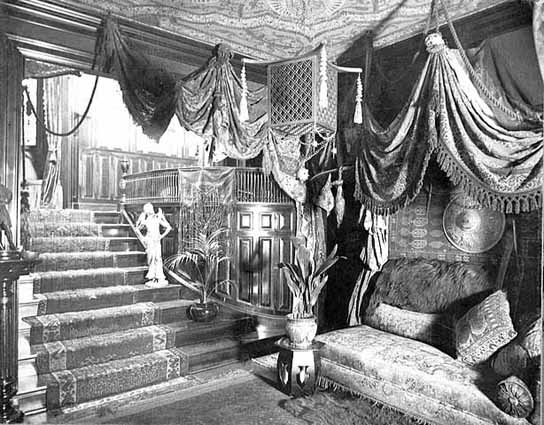
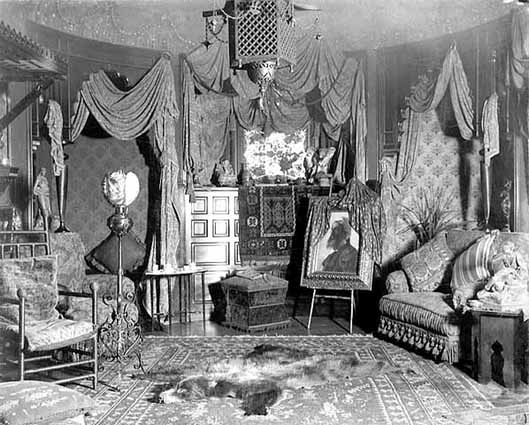
Moorish interior of Grey Court, home of Edmund G. Walton, 802 Mount Curve Avenue. Images from the Minnesota Historical Society.
Yet living in this environment did not leave Walton with an affinity for the people who had created this cultural aesthetic. Walton’s covenants specifically banned “Moors” from living in any of his subdivisions. He probably meant people with roots in North Africa. Or perhaps he thought he was barring Muslims.
It’s puzzling to our modern sensibility in so many ways. But ultimately it’s ironic that a man who inhabited a Moorish revival palace imagined African desert-dwellers as a threat to Minneapolis civic harmony and property values.
The once-lavish Grey Court has been demolished. But Walton’s other constructions have endured. Most tragically, the structures of racial inequity he erected remain firmly intact.
Sources:
Minneapolis City Directory 1910 lists “Edmund Boul,” pages 1474, 1574; “Walton’s Mississippi Heights (display advertisement),” Minneapolis Tribune January 17, 1909; Hennepin County Deeds Book 759, page 538, Document No. 712111, executed May 26, 1910, recorded April 23, 1914, East one-half of Lot 5, Block 11, Seven Oaks Acres. The original Anderson house at 3252 36th Avenue South is no longer standing and the lot has been replatted. “Learned Locally,” The Minneapolis Tribune, May 19, 1892; “Realty Men Prepared for National Convention,” Minneapolis Tribune, June 14, 1910; Letter of October 25,1887 to Mrs. Edmund [his mother] from E. G. Walton, Box 2 151.E.1.2 (E), Edmund G. Walton and Family Papers. Minnesota Historical Society; Images from the Minnesota Historical Society; Top map image from Atlas of Minneapolis, Hennepin County, Minnesota: including parts of St. Louis Park and Golden Valley Township in Hennepin County; also part of Ramsey County known as the Midway District (Minneapolis: Minneapolis Real Estate Board, 1914).